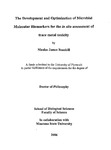The development and optimization of microbial molecular biomarkers for the in situ assessment of trace metal toxicity
| dc.contributor.author | Bouskill, Nicolas James | |
| dc.contributor.other | Faculty of Science and Engineering | en_US |
| dc.date.accessioned | 2011-09-23T14:09:42Z | |
| dc.date.available | 2011-09-23T14:09:42Z | |
| dc.date.issued | 2006 | |
| dc.identifier | Not available | en_US |
| dc.identifier.uri | http://hdl.handle.net/10026.1/639 | |
| dc.description | Merged with duplicate record 10026.1/2607 on 06.20.2017 by CS (TIS) | |
| dc.description.abstract |
Microorganisms are fundamental components of many geochemical transformations occurring in the aquatic environment. Microbial redox and methylation of metals within the environment can alter metal speciation, mobility and ultimately, toxicity to eukaryotes. It is therefore practical that any environmental monitoring framework advocating the application of `early-warning biomarker system' should incorporate a holistic view of the environment beginning with microbial activity. This thesis describes the development of protocols for assessing the in situ condition of microbial ecosystems within a gradient of metal contaminated sites radiating downstream of the Anaconda Smelter, a USEPA-designated superfund site and within two control sites. Experiments focus on evaluating the incidence (i. e. prevalence and absence) of genes related to general stress and specific metal detoxification reactions. Moreover, a number of selected genes were quantified directly from the environment and statistically correlated with metal concentrations. Furthermore, the influence of metals on structuring microbial communities was also investigated by evaluating temporal communities shifts in response to changing metal concentrations using denaturant gradient gel electrophoresis (DGGE). The data recorded the highest prevalence of all genes was found at the most polluted site directly downstream of the Anaconda Smelter. Furthermore, significant correlations were observed between gene prevalence and metals (arsenic, copper and zinc) (P < 0.05) and organic carbon concentration (P < 0.05). A number of genes were successfully amplified from sediment with significantly higher gene copy number (/ ng DNA) at the more polluted sites when compared to corresponding control sites. Examination of community diversity found that long-term metal-contaminated sediments, adjacent to the Smelter, had microbial communities twice as diverse as corresponding reference sites. In addition, multivariate statistical techniques identified factors important to community structuring, concluding that geographic position and localized geochemistry fundamentally influence the structuring of communities. This thesis represents a significant advance in the use of microorganisms as `early warning systems' of deterioration in ecosystem health, while the application of advanced molecular methods facilitates their intergration within a traditional ecotoxicological framework. | en_US |
| dc.description.sponsorship | Montana State University | en_US |
| dc.language.iso | en | en_US |
| dc.publisher | University of Plymouth | en_US |
| dc.title | The development and optimization of microbial molecular biomarkers for the in situ assessment of trace metal toxicity | en_US |
| dc.type | Thesis | |
| dc.identifier.doi | http://dx.doi.org/10.24382/3612 |
Files in this item
This item appears in the following Collection(s)
-
01 Research Theses Main Collection
Research Theses Main


